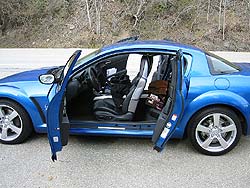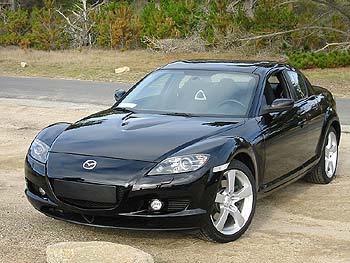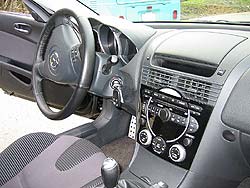

![]() First Drive
First Drive

February 10, 2003
2004 Mazda RX-8
Story and photos by Tony Whitney
Pebble Beach, California - Ever since it introduced the still-beautiful Cosmo in 1967, Mazda has had a long history of being the only automaker to persevere with rotary or 'Wankel" engines. Years ago, the company had several rotary powered vehicles in its lineup - including even a pickup truck. In more recent times, though, Mazda has concentrated on its top-end sports car range for rotary engine applications and the RX-7 has been a common sight on Canadian roads since the early 1980s.
The original RX-7 remains a classic design and there are plenty of serviceable examples around today. I owned a second generation RX-7 which I bought new and it was certainly one of the best cars I ever had. Rotary engines are delightful in sports cars and once you get used to that high-revving hum, there's almost no going back to conventional engines. There were three generations of RX-7s and then the cars disappeared entirely from Mazda's range in this country, sad to say. Before too long though, Mazda started doing the rounds of the auto shows with a concept sports car that became the 2004 RX-8 we'll be able to buy at the dealerships this year.
Right from the start, the 2-plus-2 RX-8 boasted a unique feature - an additional pair of doors to make rear seat access easier. The notion of a "four-door sports car" is fascinating to say the least and although the RX-8 might be considered a competitor for the Nissan 350Z, Honda S2000, BMW Z4 and various other rivals, the multi-door layout places it in a separate class.
 Click image to enlarge |
With cars of the popular 2-plus-2 layout, it's often very difficult to maneuver a bag over the head restraint to get it to the back seat. And moving the seatback forward can often mean that the rake must be re-set to restore your driving position.
Media at the press launch at Pebble Beach, California, were divided to some extent on what the market would think of the RX-8. Radical concepts often take a while to sink in, but we'll soon know whether buyers really want room for four grown-ups in their sports cars. My belief is that the convenience of access this car offers - combined with its impressive performance and handling - will overcome any resistance to so radical a departure from the old RX-7 layout.
Incidentally, the rear doors are specially strengthened to that when they're closed, they form a "virtual pillar" and thus don't affect the car's stiffness and rigidity - important in a performance vehicle of any kind. When I drove the car hard, I detected no body flexing at all, which is quite an achievement for Mazda's engineering people.
Styling is very dramatic, with lots of flowing bulges and blisters. It's one of those cars that will never be confused with anything else out there. The last RX-7 was a truly beautiful design and was a hard act to follow for Mazda's stylists, so it's a mistake to compare the two. Also, the RX-8 needed a high, lengthy, roofline to accommodate those rear seat passengers. My feeling is that the new RX is very dramatic-looking, but because of its unique layout, shouldn't be compared stylistically to vehicles designed for just two occupants. It could be that Mazda has created an all-new class of vehicle here.
The operation of a Wankel rotary engine is tough to describe without a model to demonstrate with, but basically, it consists of a triangular "piston" which rotates in an eccentric orbit within a figure-eight casing. The rotor has three points of contact and that's where the gas-tight seals are used. The spaces between the sides of the rotor increase and decrease in volume twice with each revolution.
The rotor spins at high speeds and is very smooth compared to a conventional engine, which involves pistons going up and down or "reciprocating." The rotary engine does not use the crankshaft, connecting rods and valves that are essential to a conventional power unit. Rotary engines are very satisfying to drive with their ultra-high revs and turbine-like feel under hard acceleration.
The RX-8 has a weight distribution close to 50:50 which makes for very good balance. Many automotive designers believe this balance to be critical to optimum performance in a sports car. Helping to achieve this weight distribution is the compactness and light weight associated with the rotary engine and Mazda's placement of the fuel tank ahead of the rear suspension and very low in the bodyshell. The centre of gravity is commendably low as a result of this packaging and handling benefits as a result. The engine drives the rear wheels via a lightweight one-piece prop shaft constructed from steel, carbon fibre and high-strength plastic. Clearly, Mazda used some very advanced technology when developing this car. Other aspects of its design show that full use was made of the latest materials and production techniques.
The transmission for the top engine is a close-ratio 6-speed manual, but the less powerful engine will be mated to a 4-speed automatic with paddle shifters mounted on the steering wheel to achieve a "semi-manual" mode. The cars I drove were fitted with the 6-speed and I found it shifted smoothly and precisely with no tendency to balk in its gate. As with similar transmissions from rival automakers, the sixth speed is more suitable for freeway cruising than any other application.
The RX-8 uses double-wishbone front suspension and long-link multilink rear suspension. Mazda believes that this suspension layout ensures a good combination of handling suppleness and ride comfort. The front suspension is a techies delight, with beautifully forged aluminum upper and lower wishbones. Not surprisingly, disc brakes with ABS are used all round, though there are different brake specifications for the two suspension options available - "sports" and "standard." As you'd guess, the sports option brings with it bigger brakes.
The cockpit of the RX-8 is very well done and it looks good as well as offering great practicality. It really is possible to fit adults in the back, but a tall driver will place some restrictions on the size of the occupant in the seat behind. There's never been an 'RX" yet that didn't have a decent array of instruments and controls and the new car is no exception. Mazda chose a two-tone interior trim approach which may not please everyone, but I liked it a lot - especially when the combination was red and black. The steering wheel is a nice grippy affair and the shift knob is easy to get at and located perfectly. It feels like one of those rare cars you "try on," rather than just sit in.
I put several hundred kilometres on a pre-production RX-8 and it performed flawlessly. On the road, it's a very well-mannered machine and response is "right there" when the time arrives for some spirited driving. The hum of the rotary engine is a constant delight and it's very tempting to drive the car a lot faster than the law allows. Just shifting through the gears and nudging the tach close to redline each time can be enormous fun, even if the speed limit is never exceeded.
I had a chance to put the car through a few punishing laps at the famed Mazda Laguna Seca race circuit in central California and it was great fun to toss the RX-8 through the turns and accelerate hard along the straight sections. It showed up well on the much-feared "corkscrew" series of bends and when I did get it wrong on one lap and drove right over the curbs, it retained its composure and was very easy to bring back under control. On an autocross course, the car held up well in tight, tire-squealing corners and was easily controllable right at the limit of adhesion. There's no question that this car handles exceptionally well.
And if you ever tire of just driving your RX-8 and listening to the hum of the rotors, the car comes with a Bose sound system of amazingly high quality. Regardless of your musical tastes, sound quality is just about as good as it gets and it would take another feature to describe exactly how Bose achieved this. Let's just say it's state-of-the-art in sports car music reproduction. Mazda worked with Bose right from the design stage to bring RX-8 buyers the best possible stereo system.
The RX-8 is clearly a sports car of great class and a fine successor to the RXs that went before. It was very bold of Mazda to take an unconventional approach to body styling with what it calls "freestyle" doors and it remains to be seen how the market will respond. My guess is that Mazda has latched onto something interesting here and if sales are strong, rival automakers will be taking a close look at customers struggling to shoehorn their passengers into the rear seating of conventional sports coupes.
No prices have yet been announced.
© 1999-2003, CanadianDriver Communications Inc., all rights reserved
Disclaimer

